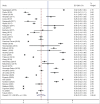Prevalence of self-medication among the elderly: A systematic review and meta-analysis
- PMID: 37113410
- PMCID: PMC10127510
- DOI: 10.4103/jehp.jehp_630_22
Prevalence of self-medication among the elderly: A systematic review and meta-analysis
Abstract
Background: Self-medication is the use of unprescribed drugs to treat a disease. Elderly self-medication can be more dangerous compared to other age groups because of changes in organ functions that occur due to senescence. This study aimed to estimate the prevalence of self-medication in the elderly, its related factors, and common drugs used in this regard.
Materials and methods: Electronic databases such as PubMed, Scopus, and Web of Science were searched between January 2016 and June 2021. The search strategy was built on two core concepts: "self-medication" and "aged". The search was limited to original articles in the English language. A random effect model was used to estimate the pooled prevalence of self-medication. Heterogeneity among studies was assessed using both the I2 statistic and the χ 2 test. Also, a meta-regression model was used to investigate the potential sources of heterogeneity of the studies.
Results: Out of 520 non-duplicate studies, 38 were included in the meta-analysis. Self-medication in the elderly ranged from 0.3% to 82%. The pooled proportion of self-medication was 36% (95% CI: 27%-45%). The result of the χ 2 test and the I2 index (P < 0.001, I2= 99.90%) revealed notable heterogeneity among the included studies in the meta-analysis. The meta-regression showed a significant association between the sample size (adjusted β = -0.01; P = 0.043) and the pooled proportion of self-medication.
Conclusion: The prevalence of self-medication in the elderly is high. Education through mass media to raise awareness about the dangers of self-medication can help solve this problem.
Keywords: Elderly; meta-analysis; prevalence; self-medication; systematic review.
Copyright: © 2023 Journal of Education and Health Promotion.
Conflict of interest statement
There are no conflict of interest.
Figures
Similar articles
-
Prevalence of self-medication with vitamin or mineral supplements in the prevention and treatment of COVID-19: a systematic review and meta-analysis.BMC Nutr. 2025 May 20;11(1):99. doi: 10.1186/s40795-025-01083-5. BMC Nutr. 2025. PMID: 40394722 Free PMC article.
-
Prevalence of self-medication during COVID-19 pandemic: A systematic review and meta-analysis.Front Public Health. 2022 Nov 3;10:1041695. doi: 10.3389/fpubh.2022.1041695. eCollection 2022. Front Public Health. 2022. PMID: 36408026 Free PMC article.
-
Prevalence and Reasons of Self-Medication in Pregnant Women: A Systematic Review and Meta-Analysis.Int J Community Based Nurs Midwifery. 2018 Oct;6(4):272-284. Int J Community Based Nurs Midwifery. 2018. PMID: 30465000 Free PMC article.
-
Global and regional estimates of prevalence of amblyopia: A systematic review and meta-analysis.Strabismus. 2018 Dec;26(4):168-183. doi: 10.1080/09273972.2018.1500618. Epub 2018 Jul 30. Strabismus. 2018. PMID: 30059649
-
Point-of-Care International Normalized Ratio (INR) Monitoring Devices for Patients on Long-term Oral Anticoagulation Therapy: An Evidence-Based Analysis.Ont Health Technol Assess Ser. 2009;9(12):1-114. Epub 2009 Sep 1. Ont Health Technol Assess Ser. 2009. PMID: 23074516 Free PMC article.
Cited by
-
Investigating the Relationship Between Self-Medication and Frequent Hospitalization of Older Iranian People Hospitalized in Yazd in 2022.Sage Open Aging. 2025 May 29;11:30495334251343243. doi: 10.1177/30495334251343243. eCollection 2025 Jan-Dec. Sage Open Aging. 2025. PMID: 40611854 Free PMC article.
-
Medication use Pattern among the Elderly in Iran: A Review Article.Int J Prev Med. 2024 Oct 18;15:51. doi: 10.4103/ijpvm.ijpvm_142_23. eCollection 2024. Int J Prev Med. 2024. PMID: 39539574 Free PMC article. Review.
-
Polypharmacy and self-medication among older adults in Indian urban communities-a cross-sectional study.Sci Rep. 2025 Feb 3;15(1):4062. doi: 10.1038/s41598-024-84627-2. Sci Rep. 2025. PMID: 39900582 Free PMC article.
-
How does the general population approach their pain? A cross-sectional study in Palestine.SAGE Open Med. 2024 Jan 22;12:20503121231223442. doi: 10.1177/20503121231223442. eCollection 2024. SAGE Open Med. 2024. PMID: 38268944 Free PMC article.
-
Prevalence of self-medication with vitamin or mineral supplements in the prevention and treatment of COVID-19: a systematic review and meta-analysis.BMC Nutr. 2025 May 20;11(1):99. doi: 10.1186/s40795-025-01083-5. BMC Nutr. 2025. PMID: 40394722 Free PMC article.
References
-
- World Health Organization (WHO). WHO supports scientifically-proven traditional medicine. 2020. [Last accessed on 20/05/2020]. Available from: https://www. Afro.who.int/news/who-supports-scientifically-proven-tradit... .
-
- Chouhan K, Prasad SB. Self-medication and their consequences: A challenge to health professional. Asian J Pharm Clin Res. 2016;9:314–7.
-
- Loyola Filho Aid, Lima-Costa MF, Uchôa E. Bambuí project: A qualitative approach to self-medication. Cad Saude Publica. 2004;20:1661–9. - PubMed
Publication types
LinkOut - more resources
Full Text Sources



